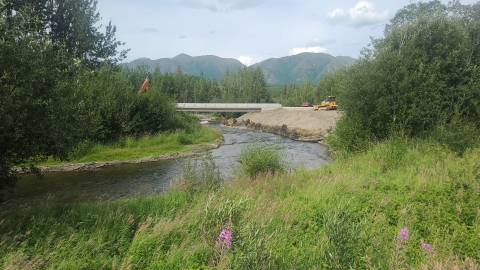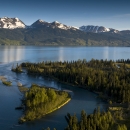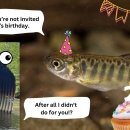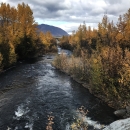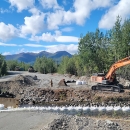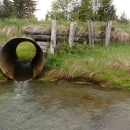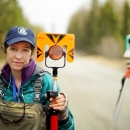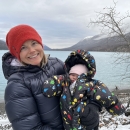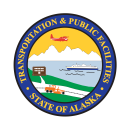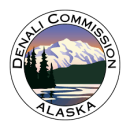States
AlaskaThis project will remove an undersized, double barrel culvert on the Little Tonsina River in the Valdez-Cordova Borough. This project is currently the highest priority barrier removal project for the Service in Alaska because of the 70.4 miles of relatively pristine Coho and Chinook Salmon spawning and rearing habitat that lie above this barrier. These waters eventually meet Alaska’s Copper River, home to what many people consider one of the world’s finest sources of salmon. The project has already attracted funding from multiple state and federal partners. The completed 100% design employs USFWS guidelines for maximizing ecological function and will support the creation of a two lane, 100 ft bridge spanning the channel and floodplain. Completion of this project not only benefits the salmon of the Copper River basin but is also expected to catalyze funding and efforts to address barriers and unstable infrastructure in nearby tributaries. More
Quick Facts:
| Project Status | Complete |
| Location | AK, Valdez-Cordova Borough |
| NFPP Project Funding | $1,318,604 |
| Restoration Techniques | Culvert Replacement |
| Accomplishments | 70.4 Stream Miles Reconnected |
| Project Partner Lead | Copper River Watershed Project |
| Primary Species Benefited | Chinook Salmon |
The National Fish Passage Program combines technical expertise with a track record of success.
Implemented primarily through the Service's Fish and Wildlife Conservation Offices, the National Fish Passage Program provides financial and technical assistance to partners across the country. Since 1999, the program has worked with over 2,000 local communities, Tribes, and private landowners to remove or bypass over 3,400 barriers to fish passage fish passage
Fish passage is the ability of fish or other aquatic species to move freely throughout their life to find food, reproduce, and complete their natural migration cycles. Millions of barriers to fish passage across the country are fragmenting habitat and leading to species declines. The U.S. Fish and Wildlife Service's National Fish Passage Program is working to reconnect watersheds to benefit both wildlife and people.
Learn more about fish passage and reopen access to over 61,000 miles of upstream habitat for fish and other animals. Staff have expertise in fish migration and biology as well as financial, engineering, and planning assistance to communities, Tribes, and landowners to help them remove barriers and restore rivers for the benefit both fish and people.
Fish passage project proposals can be initiated by any individual, organization, government, or agency. However, proposals must be submitted and completed in cooperation with a Fish and Wildlife Conservation Office. (Please note that fish passage projects being used for federal or state compensatory mitigation or required by existing federal or state regulatory programs are not eligible for funding through the National Fish Passage Program.
CONTACT A FISH PASSAGE COORDINATOR IN YOUR AREA TO GET STARTED.
